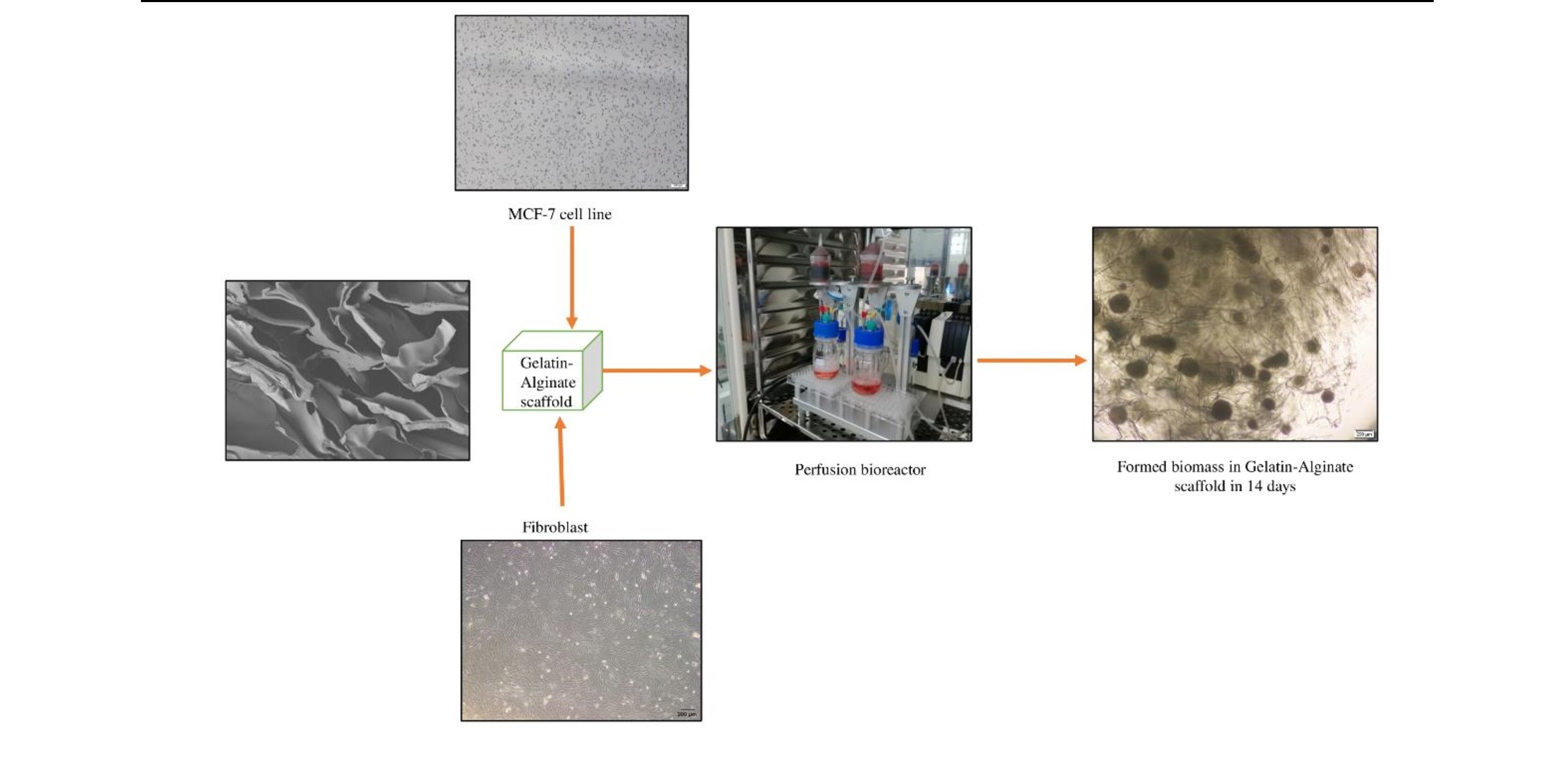Role of Co-Culture with Fibroblasts and Dynamic Culture Systems in 3-Dimensional MCF-7 Tumor Model Maturation
DOI:
https://doi.org/10.48048/tis.2023.3892Keywords:
Perfusion bioreactor, Gelatin-alginate scaffold, Human fibroblast, Breast cancer cell line, Static culture, Dynamic cultureAbstract
In vitro tumor models that are 3-dimensional (3D) have emerged as a significant area in the field of cancer research over the past several years. In order for breast cancer cell lines to grow and develop, it is important to select a scaffold, determine a strategy for seeding cells into the scaffold, then cultivate the cells under a variety of conditions. Therefore, we cultivated MCF-7 cells and fibroblasts on a gelatin-alginate scaffold alone or in co-culture under static or dynamic culture conditions in order to produce a 3D tumor model. MCF-7 and fibroblast were seeded into Gellatin-Alginate by Centrifugation and Incubation. After that, the cell proliferation was examined by MTT assay and the cell number determination in the scaffold. The morphology of MCF-7 was observed by H&E staining and SEM.
The results showed that the co-culture of MCF-7 cells and fibroblasts in the scaffold exhibited an increase in cell mass size. Their mass morphologies feature a significant number of MCF-7 cells with a round structure that persists for an extended period of time. Perfusion bioreactors also demonstrate an increase in the size of cell mass (3 times higher than static culture). As a result, the long-term stability of the structure offers the possibility of cancer biology research and drug testing, especially the sustained release or actions experiements.
HIGHLIGHTS
This research focuses on aspects of the tissue engineering concept that support the proliferation and development of specific structures within the mass. By experimenting, we were able;
- to develop co-culture with MCF-7 breast cancer cells and fibroblasts in a bioreactor system
- to form the superior cell mass up to 500 mm
- to preserve the cell mass structure for a long duration (28 days)
- to have a particularly stable mass structure, with a large number of live cells
GRAPHICAL ABSTRACT
Downloads
Metrics
References
F Xu and KJ Burg. Three-dimensional polymeric systems for cancer cell studies. Cytotechnology 2007; 54, 135-43.
A Abbott. Cell culture: Biology's new dimension. Nature 2003; 424, 870-3.
DBJ Amaral, SM Urabayashi and MG Machado-Santelli. Cell death and lumen formation in spheroids of MCF‐7 cells. Cell Biol. Int. 2010; 34, 267-74.
J Rodrigues, MA Heinrich, LM Teixeira and J Prakash. 3D in vitro model (R) evolution: Unveiling tumor-stroma interactions. Trends Canc. 2021; 7, 249-64.
K Penderecka, M Ibbs, A Kaluzna, A Lewandowska, A Marszalek, A Mackiewicz and H Dams‐Kozlowska. Implementation of a dynamic culture condition to the heterotypic 3D breast cancer model. J. Biomed. Mater. Res. B Appl. Biomater. 2020; 108, 1186-97.
J Schmid, S Schwarz, R Meier-Staude, S Sudhop, H Clausen-Schaumann, M Schieker and R Huber. A perfusion bioreactor system for cell seeding and oxygen-controlled cultivation of three-dimensional cell cultures. Tissue Eng. C Meth. 2018; 24, 585-95.
T Pan, W Song, X Cao and Y Wang. 3D bioplotting of gelatin/alginate scaffolds for tissue engineering: influence of crosslinking degree and pore architecture on physicochemical properties. J. Mater. Sci. 2016; 32, 889-900.
S Krause, MV Maffini, AM Soto and C Sonnenschein. The microenvironment determines the breast cancer cells' phenotype: Organization of MCF7 cells in 3D cultures. BMC Canc. 2010. 10, 1-13.
HTT Nguyen, QM To, TD Huynh, TC Tran and HLB Tran. Gelatin-alginate sponge: A potential scaffold for adipose tissue engineering. Eur. J. Biomed. Pharmaceut. Sci. 2015; 2, 48-53.
NT Nguyen, VN Doan and HLB Tran. Generating in vitro solid tumor models on gelatin-alginate scaffolds. Vietnam J. Sci. Tech. Eng. 2018; 60, 25-30.
LH Nguyen-Thi, ST Nguyen, TP Tran, CN Phan-Lu and PV Pham. Anti-cancer effect of Xao Tam Phan Paramignya trimera methanol root extract on human breast cancer cell line MCF-7 in 3D model. Adv. Exp. Med. Biol. 2020; 1292, 13-25.
LA Kunz-Schughart and R Knuechel. Tumor-associated fibroblasts (part II): Functional impact on tumor tissue. Histol. Histopathol. 2002; 17, 623-37.
W Godbey, BS Hindy, ME Sherman and A Atala. A novel use of centrifugal force for cell seeding into porous scaffolds. Biomaterials 2004; 25, 2799-805.
HK Dhiman, AR Ray and AK Panda. Three-dimensional chitosan scaffold-based MCF-7 cell culture for the determination of the cytotoxicity of tamoxifen. Biomaterials 2005; 26, 979-86.
G Xiong, H Luo, Y Zhu, S Raman and YJC Wan. Creation of macropores in three-dimensional bacterial cellulose scaffold for potential cancer cell culture. Carbohydr. Polym. 2014; 114, 553-7.
H Zheng, W Tian, H Yan, L Yue, Y Zhang, F Han, X Chen and Y Li. Rotary culture promotes the proliferation of MCF-7 cells encapsulated in three-dimensional collagen-alginate hydrogels via activation of the ERK1/2-MAPK pathway. Biomed. Mater. 2012; 7, 015003.
H Wang, J Qian, Y Zhang, W Xu, J Xiao and A Suo. Growth of MCF-7 breast cancer cells and efficacy of anti-angiogenic agents in a hydroxyethyl chitosan/glycidyl methacrylate hydrogel. Canc. Cell Int. 2017; 17, 1-14.
L Chen, Z Xiao, Y Meng, Y Zhao, J Han, G Su, B Chen and J Dai. The enhancement of cancer stem cell properties of MCF-7 cells in 3D collagen scaffolds for modeling of cancer and anti-cancer drugs. Biomaterials 2012; 33, 1437-44.
LT Somasekharan, R Raju, S Kumar, R Geevarghese, RP Nair, N Kasoju and A Bhatt. Biofabrication of skin tissue constructs using alginate, gelatin and diethylaminoethyl cellulose bioink. Int. J. Biol. Macromol. 2021; 189, 398-409.

Downloads
Published
How to Cite
Issue
Section
License
Copyright (c) 2022 Walailak University

This work is licensed under a Creative Commons Attribution-NonCommercial-NoDerivatives 4.0 International License.






